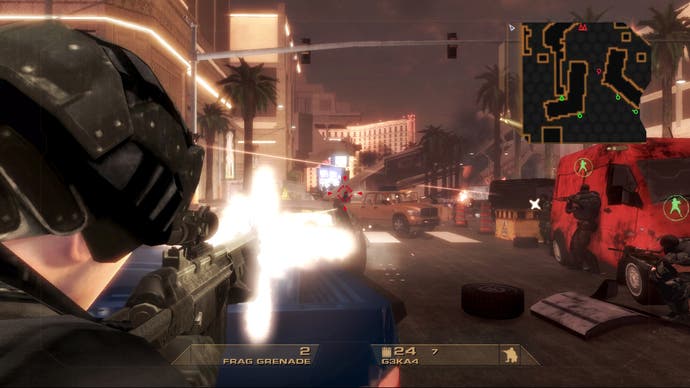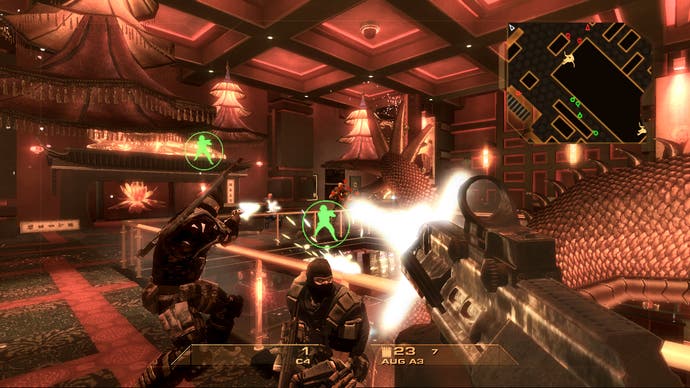Tom Clancy's Rainbow Six: Vegas
Six and the City.
Tom Clancy's Rainbow Six: Vegas on the PC is basically identical to Tom Clancy's Rainbox Six: Vegas on the Xbox 360. Since Kristan reviewed it across three pages, surely that means I can wrap up my first review of the year in record time and finally start my Christmas shopping.
About that - once again, Tom's not publishing one of my reviews for a week makes me sound like more of an arse than I am. I can't remember when I submitted this, but it was definitely my last review of 2006 and not the first of 2007. That's Tom being a filthy lying liar again.
Although, actually, I'm misleading you as well, since I obviously can't end the review here, however much I'd like to. I'm not going to waste any significant part of my word-count on discussing things like the specific weapons, either. Instead, I'm going to waste my word-count on a traditionally over-long intro, before going on to try and argue why I'm giving it a seven rather than an eight on the PC, despite it being almost the same game.
(And then segue into the usual overlong outro, among other things.)
(There may even be some nob gags.)

It's important to note that every positive quality that Vegas has on the Xbox 360 is carried faithfully across to the PC. Generally, aesthetics are right-proper next-generation like. For example, its visualisation of the Vegas strip is unparalleled in terms of its ultra-bright vibrancy. Its animation throughout is of the highest quality, the influence of the various Tom Clancy games clearly shown in things like the rappelling down walls. The expanded skill-set is exciting, allowing a generalised form of siege warfare. While you only have two team-mates, they're (generally) the smartest yet and (generally) a pleasure to control. The system for taking cover is as comprehensive as Gears of War, but more suited to the game's slower pace. Guns are very loud. It walks the line between frustrating and challenging with (mostly) admirable skill. Vegas is a perfect setting for a game - mazy, which creates tactical uncertainty, but also naturalistic, so the player's never left thinking that all these slot machines providing convenient cover are just the developer cheating (after all, this is what Vegas is really like). And the multiplayer options - especially the co-op - are enough to secure a high mark by themselves. The terrorist-hunt with several friends is a gift that keeps on giving.
Most obviously, it really is about half a billion times better than Rainbow Six: Lockdown (Or "Rainbow Six: Gagging Faeces Down", as the wags at Eurogamer towers call it when Grown Ups are out of the room).
(I jest - there are no Grown Ups at Eurogamer towers.)
For PC fans of Rainbow Six, the actual fall into Lockdown was even more alienating than those who'd only known it in console incarnations. Rainbow Six probably takes a prize as the series of games that's wandered furthest from its original inspiration while sticking to the same genre. The original PC Rainbow Six games were unique, all about prior planning and then storming the objective. Most of your time would be spent laying down waypoints before trying an execution. It was perilous. It was exciting. It was enormously alienating to anything approaching a mass-market audience.

So, understandably, the techno-thriller became more thriller and less techno, borrowing aspects of everything from SWAT 3, Brothers in Arms and chums (and, to be fair, they pillaged Rainbow Six exactly as much back). The tactical shooter turns more shooter...
Well, this is where it begins to grate on the PC. Here too.
(Actually, I lie again. It begins to grate when it's clear that the multi-format development has lead to some small, thoughtless pieces of design due to its Xbox 360 prioritisation. For example, when your team have grouped up behind the door, ready to storm, it displays the possible methods for clearing the room on icons on the bottom left of the screen. On the Xbox, they're presumably chosen by something sensible like the d-pad, so you know by pressing "left" you get the "left" option. However on the PC this is mapped to three buttons on your keyboard. Which one is the left one of the three? You better get it right first try, because, if you don't, you may end up just grenading a room full of hostages. The sad thing is that PC owners get the worst of both worlds. People think we'd be crazy idealists to ask for features like the split-screen ported over, but still have to deal with a control system they simply haven't thought about enough. Oh and, in passing, the specs are freaky high, demanding Pixel Shader 3.0 tech at least in your 3D card.)
Some out there would say that forgetting a key or just hitting the wrong one is a player's weakness. [Shouldn't you still be in parentheses? -Tom] Yeah, but (in both cases, boss) it's an understandable human weakness that should be planned for, which is the key problem with the save-point-only system that Rainbow Six chooses to apply. The game simply features far too many variables that could go wrong for frustration not to peak when you have to replay the whole long section - at a slow rate, due to the game's nature - when something goes randomly tits-up. As Kristan argued, elements like being able to resurrect your fallen team-mates from the vast majority of deaths help alleviate this. Elements like enemies that throw one-hit-kill frag grenades - in closed environments where you are mostly likely facing the other direction or otherwise unaware - really don't.

And we get there again. When Rainbow Six was a "realistic" game, you forgave this as part of the whole thing, as an essential aspect of its atmosphere. But as the game becomes more of a plain shooter, these elements seem increasingly out of place. Despite Vegas being an incredible setting for a videogame, the atmosphere suffers from this confusion of priorities. For example, take the first mission in sin city, where your initial task is to blow a hole in the wall to avoid the main entrance, which is "too heavily defended". To get to this wall you have to make your way up the strip in a firefight against literally dozens of terrorists. Right. How more heavily defended can this other entrance be? Do they have enormo-robots? The Incredible Hulk? All the accurately rendered weapons in the world can't hide that this is no longer a realistic game in any sense of the word.
Which is the problem with the game on the PC. It feels like an undecided halfway house between two genres - both of which the PC excels at - and it's incapable of deciding which one it wants to be. Elements of the old games stand proud, like an enormous inventory of weapons with which you can equip yourself, in massive detail. Except you often get to browse this enormous array of weapons in crates slapped in the middle of levels, as though SWAT armouries are as common as slot machines in Vegas. You have better-than-ever room-clearing skills with your team... but the vast majority of confrontations are just working through relatively open environments. If you want an atmospheric tactical shooter, SWAT 4 walks over this. If you want an actual shooter then... oh, this is the PC. Take your pick.
Which leaves you suspecting that for all its fun and technology, that Rainbow Six: Vegas is actually a half-way house between the past and... something else.
It just needs to decide what.








